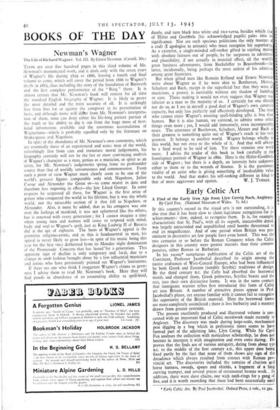Early Celtic Art
IF this country's record in the visual arts is not outstanding, it is also true that it has been slow to claim legitimate recognition for its achievements: slow, indeed, to recognise them. It is, for example, characteristic that St. Paul's, with all its superb, inaccessible detail, was largely unrecorded and unpublished until bombs threatened to end its magnificence. And of one period when Britain was pre- eminent in decorative art few people have even heard. This was the two centuries or so before the Roman Conquest when the Celtic designers in this country were greater masters than their contem- poraries, either Roman or Barbarian.
In his recent* sumptuous publication of the Celtic art of the Continent, Professor Jacobsthal described its origin among the native craftsmen of West-Central Europe, who had been influenced by both Greek and Eastern (notably Scythic) traditions of design. By the third century B.C. the Celts had absorbed the borrowed motifs and changed them, Greek palmettes, Scythic beasts and the rest, into their own distinctive forms. It was in the same century that immigrant warrior tribes first introduced this form of Celtic art into Britain. A number of attractive pieces appear in Prof. Jacobsthal's plates, yet anyone familiar with it cannot fail to recognise the superiority of the British material. Here the borrowed forms are more completely assimilated ; there is less barbarity and a mastery drawn from greater restraint.
The present excellently produced and illustrated volume is con- cerned with an important find of Celtic metalwork made recently in Anglesey. The discovery was made during large-scale, mechanised peat digging in a bog which in prehistoric times seems to have formed part of the adjoining lake, Llyn Cerrig. While Sir Cyril Fox analyses the collection with meticulous scholarship, he does not hesitate to interpret it with imagination and even some daring. He proves that the finds are of various antiquity, dating from about 150 B.C. to the middle of the first century A.D., this upper date being fixed partly by the fact that none of them shows any sign of the decadence which always resulted from contact with Roman pro- vincial art. The discoveries included the remains of chariots and horse harness, swords, spears and shields, a fragment of a. tong curving trumpet, and several pieces of ornamental bronze work. In addition, there were slave chains, one with neck-rings for a gang of five, and it is worth recording that these had been successfully used * Early Celtic Art. By Paul Jacobsthal. Oxford Press, 2 vols., To gas.
for hauling mud-bound lorries before their venerable age was recognised. None of these things seems to have been made locally ; they can be identified as coming from most of the main centres of Celtic art, Yorkshire East Anglia, South-West England and even Ulster. Among the finest pieces are bronze and iron horse-bits which display a faultless use of plastic moulding in a purely func- tional context. But most remarkable of all is a crescentic bronze plaque whose panel of ornament in low relief illustrates the Celtic decorative genius at its most accomplished. It has an asymmetry which is subtly balanced, and succeeds in making the matrix of space as powerfully effective as the design itself. It is wholly abstract, yet there is some strange movement in it ; is simple to austerity, yet the curved surfaces of the repousse work lend a certain voluptuousness.
The historical interest of the Llyn Cerrig find is no less than the aesthetic. Sir Cyril Fox has to ask what economic or social force it was that drew luxury goods to Anglesey from so many quarters of Britain and from Ireland. The druidical importance of the island in Celtic times is well known ; with lurid ornament Tacitus describes how the druid priests and their followers were annihilated by Roman legionaries in 6i A.D. There is little doubt that druid power and wealth had some responsibility for the accumulation of the Llyn Cerrig treasure ; it is even reasonable to imagine that the slave chains were once used to secure sacrificial victims. It seems that all the Celtic objects had been thrown info the water from a jutting rock-shelf, and it may be that they were votive offerings made to some god, or spirit of the pool. But the author has also an alternative explanation. This great welter of goods might have been seized from the druid community after the slaughter of 61. The Roman soldiers roused by victory and their fear and hatred of the priests, took their possessions, things of beauty equally with slave chains, and hurled them into the lake. It is an attractive interpretation, for it would link the Llyn Cerrig treasure, these pieces of bronze and iron found so much by chance, with the events of a particular day of recorded history.
JACQUETFA HAWKES.



























 Previous page
Previous page